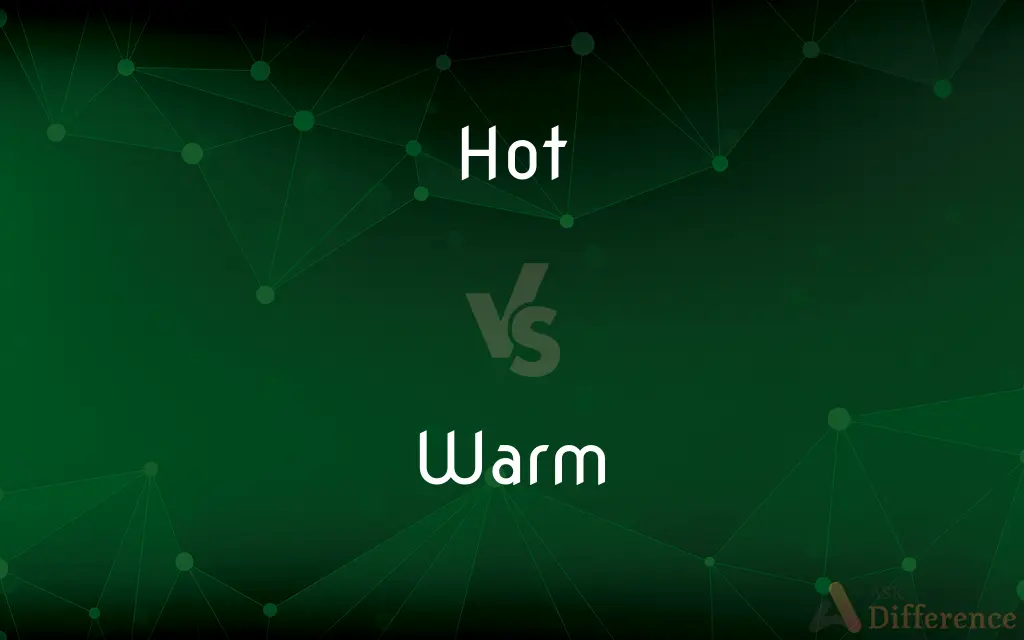Hot vs. Warm — What's the Difference?
Edited by Tayyaba Rehman — By Urooj Arif — Updated on March 3, 2024
Hot implies a high temperature, while warm suggests a moderately high temperature that is pleasant and not too hot.

Difference Between Hot and Warm
Table of Contents
ADVERTISEMENT
Key Differences
Hot and warm are both terms used to describe temperature, but they convey different levels of heat. Hot is used to describe temperatures that are significantly high, often to the point of causing discomfort or being unsafe to touch without protection. Warm, on the other hand, refers to a more moderate level of heat that is generally pleasant to the touch and conducive to comfort.
A hot day might have temperatures soaring above what is considered comfortable for outdoor activities, possibly leading to heat advisories. A warm day, however, would be ideal for spending time outside, with temperatures that are enjoyable but not excessive.
The perception of what constitutes hot and warm can be subjective and vary depending on the context and personal tolerance. For instance, in cooking, hot might refer to a temperature that cooks food quickly or boils water, whereas warm might be used for gently heating ingredients or keeping food ready to serve.
Touching a hot surface can result in pain or burns, indicating that the temperature is at or above the threshold for causing tissue damage. Touching a warm object, however, is often comforting and can help to relax muscles without the risk of harm.
The distinction between hot and warm also plays a role in product descriptions and instructions, where it is important to convey the appropriate level of heat for safety and efficacy. For example, instructions may specify using warm water to dissolve yeast for baking, as hot water could kill the yeast and impede the baking process.
ADVERTISEMENT
Comparison Chart
Temperature
Significantly high, often uncomfortable or unsafe.
Moderately high, pleasant and comfortable.
Context
Can indicate danger or the need for caution.
Suggests comfort and suitability for relaxation.
Physical Sensation
Can cause pain or burns upon contact.
Comforting to the touch, without risk of harm.
Weather
Temperatures that may lead to heat advisories.
Ideal for outdoor activities, not excessively hot.
Cooking
Used for quick cooking or boiling.
Used for gentle heating or keeping food ready to serve.
Compare with Definitions
Hot
Weather conditions that are excessively warm, leading to discomfort.
The day was hot, with temperatures reaching over 100°F.
Warm
Describing a level of affection or cordiality in interactions.
They received a warm welcome at their grandmother's house.
Hot
Indicative of a high degree of intensity or enthusiasm.
The debate became hot as opinions strongly diverged.
Warm
Comfortably high temperature, pleasant and not causing discomfort.
The blanket was warm, providing comfort on a chilly night.
Hot
Having a high temperature, especially to the extent of being uncomfortable or causing burns.
The metal handle was too hot to touch without gloves.
Warm
Used to describe the stage of readiness or nearness to achieving something.
Her guesses were getting warm, closer to the right answer.
Hot
Used to describe spicy food with a strong heat level.
The soup was too hot for her to eat without reaching for water.
Warm
Indicating a moderate level of spice or flavor in food.
The salsa was warm, adding a nice flavor without being overpowering.
Hot
Referring to items in high demand or trending.
That song is really hot right now on the charts.
Warm
Referring to a mild level of enthusiasm or interest.
The audience's response was warm, appreciative but not overly enthusiastic.
Hot
Having or giving off heat; capable of burning.
Warm
Of or at a fairly or comfortably high temperature
I walked quickly to keep warm
A warm September evening
Hot
Being at a high temperature.
Warm
Having or showing enthusiasm, affection, or kindness
They exchanged warm, friendly smiles
A warm welcome
Hot
Being at or exhibiting a temperature that is higher than normal or desirable
A hot forehead.
Warm
Somewhat hotter than temperate; having or producing a comfortable and agreeable degree of heat; moderately hot
A warm climate.
Hot
Charged or energized with electricity;
A hot wire
A live wire
Warm
Having a temperature slightly higher than usual, but still pleasant; mildly hot.
The tea is still warm.
This is a very warm room.
Warm
The act of warming, or the state of being warmed; a warming; a heating.
Warm
Of a seeker; near to the object sought;
You're getting warm
Hot on the trail
Common Curiosities
Can weather be described as warm and hot in the same day?
Yes, temperatures can start as warm in the morning and become hot by the afternoon, depending on weather patterns and time of year.
Why is it important to distinguish between hot and warm in cooking?
Certain cooking processes and ingredients require precise temperature control to achieve desired results, making the distinction critical for success.
Is the perception of hot and warm subjective?
Yes, individual tolerance and perception of temperature can vary, making the distinction between hot and warm somewhat subjective.
Can drinks be described as hot or warm?
Yes, drinks like coffee or tea are often described as hot when freshly made and warm as they cool to a more comfortable drinking temperature.
How does clothing relate to being hot or warm?
Clothing designed for cold weather aims to keep the body warm, whereas wearing too much in hot weather can lead to overheating.
How do I know if water is hot or warm?
Hot water can produce steam or be too uncomfortable to keep your hand in for more than a few seconds, while warm water feels pleasant and is safe for prolonged contact.
Can "hot" and "warm" be used interchangeably?
While both describe temperatures above cool or cold, they are not interchangeable due to their distinct implications of heat intensity.
How do animals perceive hot and warm?
Animals have their own comfort ranges for temperatures, which can influence their behavior and habitats, similar to humans' preference for warm or avoidance of hot conditions.
Do "hot" and "warm" have the same emotional connotations?
No, "hot" can imply intensity or passion, whereas "warm" often conveys comfort, friendliness, or mild enthusiasm.
Is there a specific temperature range that defines hot and warm?
Specific ranges can vary, but generally, warm temperatures are considered to be between 20°C to 30°C (68°F to 86°F), while hot temperatures are above this range.
Share Your Discovery

Previous Comparison
Gummy vs. Gummi
Next Comparison
Polite vs. GentleAuthor Spotlight
Written by
Urooj ArifUrooj is a skilled content writer at Ask Difference, known for her exceptional ability to simplify complex topics into engaging and informative content. With a passion for research and a flair for clear, concise writing, she consistently delivers articles that resonate with our diverse audience.
Edited by
Tayyaba RehmanTayyaba Rehman is a distinguished writer, currently serving as a primary contributor to askdifference.com. As a researcher in semantics and etymology, Tayyaba's passion for the complexity of languages and their distinctions has found a perfect home on the platform. Tayyaba delves into the intricacies of language, distinguishing between commonly confused words and phrases, thereby providing clarity for readers worldwide.
















































